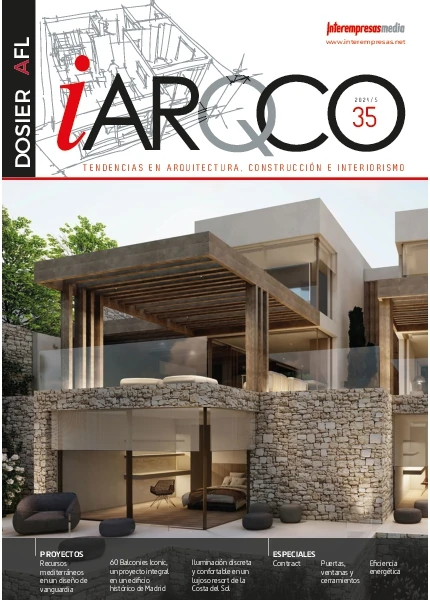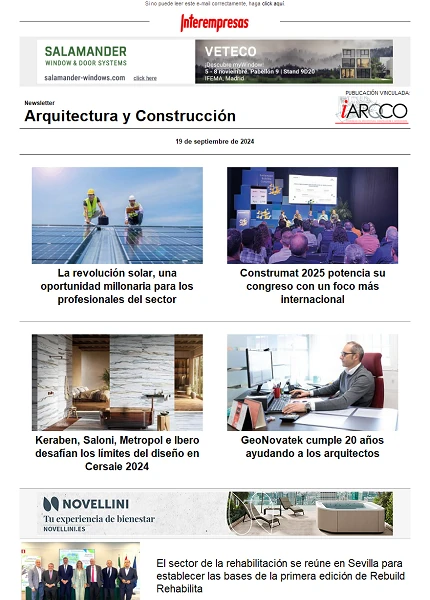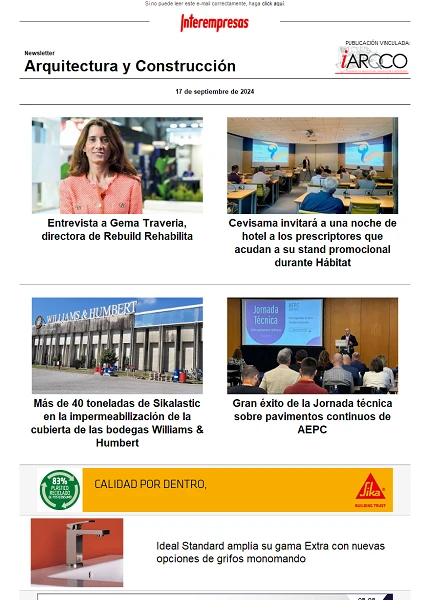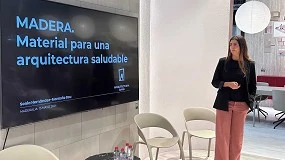The saving of water
4 May 2012
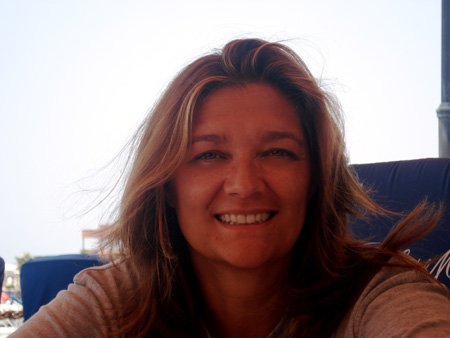
Have in front of us a challenge and a need, like citizens and like employers. The environingingmental consciousness and of energetic saving is very present in the society, but the subjects of water have happened to a flat second. The distributors members of Amascal have in his warehouses a good number of products that are able to help in this saving of water as well as other respectful with the half and effective in the use of alternative energies; taps that reduce the discharge, cisternas with double pulsador that adapt to the needs of water, recicladores of water of shower for other uses, etc. Independently of the utilisation of these products that boost the saving of the water, the good state of the installations turns into fundamental to avoid the escapes of water.
When it speaks of reform and rehabilitation seems that the important is the structure of the buildings and the thermal sensors insulation. Still being like this, do not have to forget that they exist other factors that inciden in the possible escapes of energetic resources: the taps and toilets that bead, the worn boards, valves oxidadas and broken, can be another leakage of water and therefore of this so esteemed resource.
Why the distinct codes and rules do not do greater upsetting in the subject of the water? The answer is simple, the water does not explode, neither burns, and in general, and except cases of natural disasters, does not cause the loss of human lives.
To be able to calibrate the impact of the saving of the water have to take into account three important factors although no only: of a side the antiquity of the buildings in Spain and his possible reform and rehabilitation and, by the another, the price of the water.
Also is necessary to contemplate other questions, like the irrigation or the supply of water to the industry implanted in our country and, of course, the existent legal frame.
Antiquity of the park of houses in Spain
The park edificatorio Spanish has a total of 3.500 million m2 built, of which 85% is allocated to residential uses and 15% remaining to other tertiary uses, mainly with administrative and commercial ends.
According to the official statistics, the park of houses in Spain in 2008 was formed by 25.129.027 houses, of which 67% were main houses and the another 33 % remaining, second residences.
The residential park Spanish is relatively young, with a half antiquity roughly of 35 years. 70% of the existent houses were edificadas subsequently to 1960, being the houses finished between 1971 and 1980 those that compose the most frequent interval (23,4% of the total), followed of those built in the period 1961-1970 (17,3%).
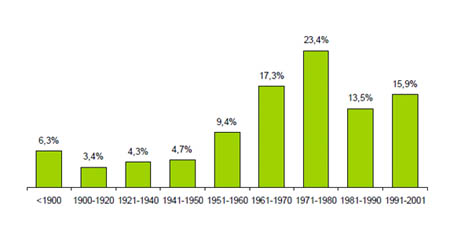
By types of homes, find how have increased in each one of the categories, considering an estimate until the 2008 since they do not have of official data.
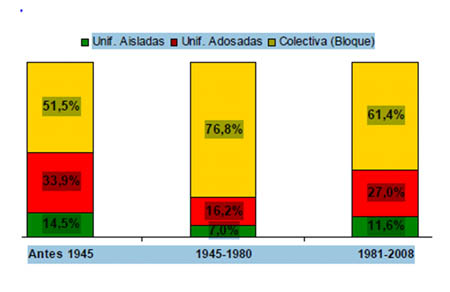
The rehabilitation
In our country, the energetic rehabilitation offers a wide potential of development, although traditionally it has had a residual weight inside the activity of the sector. The rehabilitation represented in 2009 so only 19% of the total investment of the construction in Spain, in front of 43% of average in the EU. In Germany, for example, the works in existent buildings suppose 62% of the activity of the sector and the new construction something more than 37%. The tax of Spanish annual rehabilitation is, comparatively, also very low. Considering the rhythm established inside the State Plan of House and Rehabilitation, would take 106 years in rehabilitating 100% of the park of existent houses (taking like year of reference the number of houses in 2008).
Opens therefore an enormous field also to the improvement of the installations of water, because although the average of the buildings in Spain consider low, is not it in terms of desgate of the installations. The valves, latiguillos, mechanisms, together and other products in contact with the water during 35 years, sure that are dilapidated being therefore susceptible of breaks and loss of water.
The house of recent construction neither is in better conditions. The enormous quantity of buildings built in the last 10 years has not had the quality and technological innovation expected.
The price
The water supply and sanitation in Spain is characterized by universal coverage and a good quality of service. Around of 60% of the population is supplied by private companies that operate through concessions of the municipalities. Spain's largest supply company comprises 50% of the private market concessions.
Daily spending per individual in 171 litres, 121 more than that established by the World Health Organization as the minimum volume to meet basic needs.
According to the latest report published by the Ministry of environment 'Prices and costs of the services of water in Spain', the Spanish pay 1.08 euros per cubic meter of household when the cost of the water supply and sanitation "is notably higher", that is because these costs "are largely funded by the Government and are not loaded fully on the invoice of the users".
The European water framework directive sets before 2010, the receipt of water paid by the citizens of Europe must include all costs of supply, including the treatment and management of wastewater.
Therefore it is a priority that technological advances are known by all users of water either families or institutions.
Spain is considered to be one of the most stressed by the consumption of water and the OECD considers unacceptable the high consumption of water in our country.
One of the priorities in implementing a system of reduction of water consumption is to know what is the real cost of water.
-Purchase price: undertakings charged a price per cubic metre of water served that, depending on the geographical area can vary between 0, 25-0, 30/m3 (40-50 pts/m3) to more than 1.2/m3 (200 pts/m3).
-Dumping price: Dumping price is function of the volume of poured water and concentration of contaminants.
-Cost of pumping: Self-sufficiency or mains water storage, the cost of pumping is function of the flow as the pressure and the performance of the drive system.
-Maintenance costs:Maintenance of pumps, flow meters, counters and pipelines that get damaged by the corrosiveness of the water and its compounds or calcareous deposits.
-Cost of treatment:In the case of pre-treatment of contribution, softening or reverse osmosis water. We must take into account both the costs of acquisition of technology and the purchase of reagents. In the case of final purification, installation acquisition, the purchase of reagents and the management of waste generated (with the consequent loss of raw).
-Loss of the material value of the equipment: both drive, control, conditioning and driving.
Minimizing water consumption, will therefore result in a minimization of all costs listed here.
to.- REDUCTION OF THE DISCHARGE
The last advances in griferías reduce considerably the discharge of water. In some cases, arrive to limit the consumption of water in the showers of a discharge of 14 litres by minute of a conventional team, to a discharge of between nine and 12 litres by minute, allowing a saving of until the 25 percent. Of this form, a family of four people in which all his members take a daily shower of five minutes of length could save every year until 36.500 litres, what represents a 25 percent of his consumption of current water in this use.
Equally, the taps that employ these technologies reduce his discharge of nine litres by minute in a conventional tap until 7,2 litres by minute, saving a 20 percent of water, what would allow to the families and institutions reduce his bill of water.
b.- RECYCLED
Exist at present systems of recycled of domestic water which allow that a family can reutilizar the water used of the toilet and of the shower by means of a mechanical system 100 by one hundred biological, totally automated and that does not need maintenance. In the case of Germany, for example, these equipment “can treat daily between 600 and 10.000 litres of pertinent water of the shower and the toilet so that it was reusable in washing machinees, cisternas of the WC, domestic cleaning or irrigation of the garden”, by what a family of four people “could save more than 90.000 annual litres with the employment of this technology, reducing his current consumption of water until in more than a 48 percent”. In Spain, considering that the price of the water is cheaper and the per capita consumption higher, the potential of saving is still greater.
c.- REVISION OF INSTALLATIONS
The periodic reviews of boards, buoys of cisternas, pulsadores, fluxómetros, pumps, equipment of pressesure, latiguillos and other components of the installations of water and saneamiento of the buildings and houses more ancient could suppose a remarkable saving of water in addition to a relaunching of the activity of reform and rehabilitation.
A tap that beads full by half term 25 by minute what translates in 1,5 litres in an hour, 36 litres to the day or 13.140 litres to the year.
The figures speak by himself alone, is necessary to carry out a plan of review of the installations, so much in the familiar residences as in the industrial and agricultural and diminish like this noticeably the losses of water by the deterioration of the installations with the step of the time


